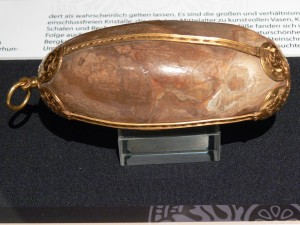Never heard of a bezoar, never mind an alpaca one? Prepare to be enlightened.
It looks like a semi precious stone and it is a stone – of a sort! A bezoar is a gall stone made up of the unlovely combination of calcium and hair. It is found in the alimentary tracts of ruminants like deer, sheep, llamas and alpacas.
Bezoars were believed to have magical qualities and to bring luck, health and power to the wearer. According to my research, Queen Elizabeth I had several bezoar stones in one of her crowns.
But the most significant quality of the bezoar was its alleged ability to counteract poisoning. Apparently the word bezoar comes from the Persian pá to zahar, which means “antidote against poison.” Their popularity peaked in the 17th century when being poisoned was a bit of an occupational hazard.
Fact or Myth?
An article by Corey Malcolm, Director of Archaeology of the Mel Fisher Maritime Heritage Society describes the results of modern scientific study into the anti-poisoning effect of bezoars. He writes: “Modern examinations of the properties of bezoars by Gustaf Arrhenius and Andrew A. Benson of the Scripps Institution of Oceanography have shown that they could, when immersed in an arsenic-laced solution, remove the poison. The toxic compounds in arsenic are arsenate and arsenite. Each is acted upon differently, but effectively, by bezoar stones. Arsenate is removed by being exchanged for phosphate in the mineral brushite, a crystalline structure found in the stones. Arsenite is found to bond to sulfur compounds in the protein of degraded hair, which is a key component in bezoars.”
So there you have it. Belief in the power of the bezoar appears to be well founded, for poison at least. As to conferring the owner with luck and power, well, that’s going to be a little bit harder to prove.
